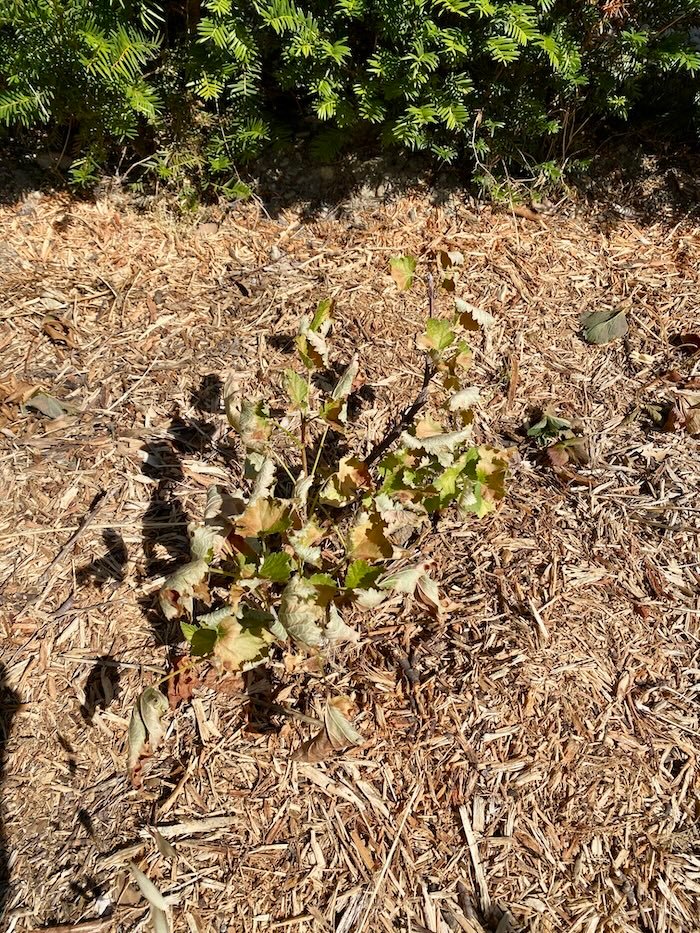The Mediterranean climate is not famous for mild summers, generous rains or generous freshwater supplies. Instead it is famous for scorching summer temperatures, heatwaves with up to 40 degrees and months on end without rain: difficult planting conditions.
It only makes sense therefore to choose plants wisely instead of trying to establish old favorites from other, cooler and/or wetter, regions. It will do nothing but break one’s heart.
Yes, depending on local microclimate, plants like Hydrangea, Acer palmatum and the like may be able to flourish in a sheltered, shady garden. However, even then they will need constant watering in summer and is that worth the effort, seeing that there are so many beautiful plants fully equipped to handle the Mediterranean climate?
Since before we finally moved here I researched and made lists over lists of plants that should work. But before I actually lived through a Mediterranean summer I simply could not imagine how hot and how dry it can be. So my favorite Aquilegia I thought I just MIGHT be able to grow in a shady corner were doomed from the start.
And even after living here there were many times when I simply trusted a garden center description instead of doing my own research. Yes, Dianthus gratianopolitanus may like full sun and have little water requirements but it is native to mountains and highlands, not the Mediterranean plains. Most garden centers are there to make money and have you come back for more next season. So there were quite a few opportunities for kicking myself in the proverbial butt.
And then again, there’s only so much research that can be done and sometimes information just can not be found online – as incredible as that may sound nowadays. So some things simply have to be tried. Like planting various types of runner beans for two years before finally concluding that they just don’t work here, at least not for producing edible beans.
There are countless other examples for failures and someday I will list them all…
My Sources for Research
Disclaimer: I am going to mention two commercial re-sellers as very important sources of information. Not because I am getting paid for mentioning or linking them but because to me they offer the very best in plant information.
Promesse de Fleurs
It’s not 100% correct 100% of the time, but this garden center website (also available in English and other languages) is to me one of the very best when it comes to filtering for and finding extensive data and information for each plant it sells. Among information like planting and flowering season, growth habits, frost hardiness, etc. it will note whether plants are suited for oceanic, continental, mountain, or mediterranean climates.
What are the differences? Mountain and continental climate plants need lower general temperatures and/or a wider difference between summer and winter, day and night temperatures. Oceanic climate plants thrive on rainfall, constant humidity in the air, and moderate temperatures – like on the Atlantic coast, not the Mediterranean.
Wikipedia
I corroborate “commercial” information by looking on Wikipedia to see where the plant in question is native or naturalized. For some reason German-language Wikipedia is more forthcoming with this type of information under the header of “Vorkommen”, “Verbreitung”, or “Standort”.
Jardin sec
Olivier Filippi, the famous “Dry Garden” specialist, author, and owner of Pépinière Filippi in Mèze has tagged all plants he sells with a very practical “code de secheresse”.
These codes from 1 to 6 denote the time a plant will be able to withstand summer drought – not in weeks, but in months. Thus a plant with a code of 3 should be able to withstand 3 summer months without rain. Though all of our plants are code 3 and up, I admit that I have not yet had the courage to not water for that long a time – but then again most of our plants are not fully established yet. Only plants with a code of 3 and up will be fit for a true “dry garden” or “jardin sans arrosage”. Plants with a code of 6 will be fully resistant and stem from desert-like regions.
It’s important to note that sun exposure, the amount and direction of wind, as well as the nature and depth of the soil will also play a role in a plant’s drought resistance. Filippi therefore suggests looking at plants that are doing well in one’s own garden, the neighbor’s garden or in the local area. His example: if Viburnum tinus with a code of 3 thrives locally, then other plants with the same code should work without water as well – ONCE they are well established, of course, which is usually after one or two summers.
What about Frost?
Besides drought resistance it is also important to take local winter temperatures into account when choosing plants. Many areas in the South of France do get frost in the winter and though it usually happens for a few hours in the very early morning, it will kill plants that are overly sensitive to it.
The image at the tops shows a doomed red currant shrub in summer.

Leave a Reply